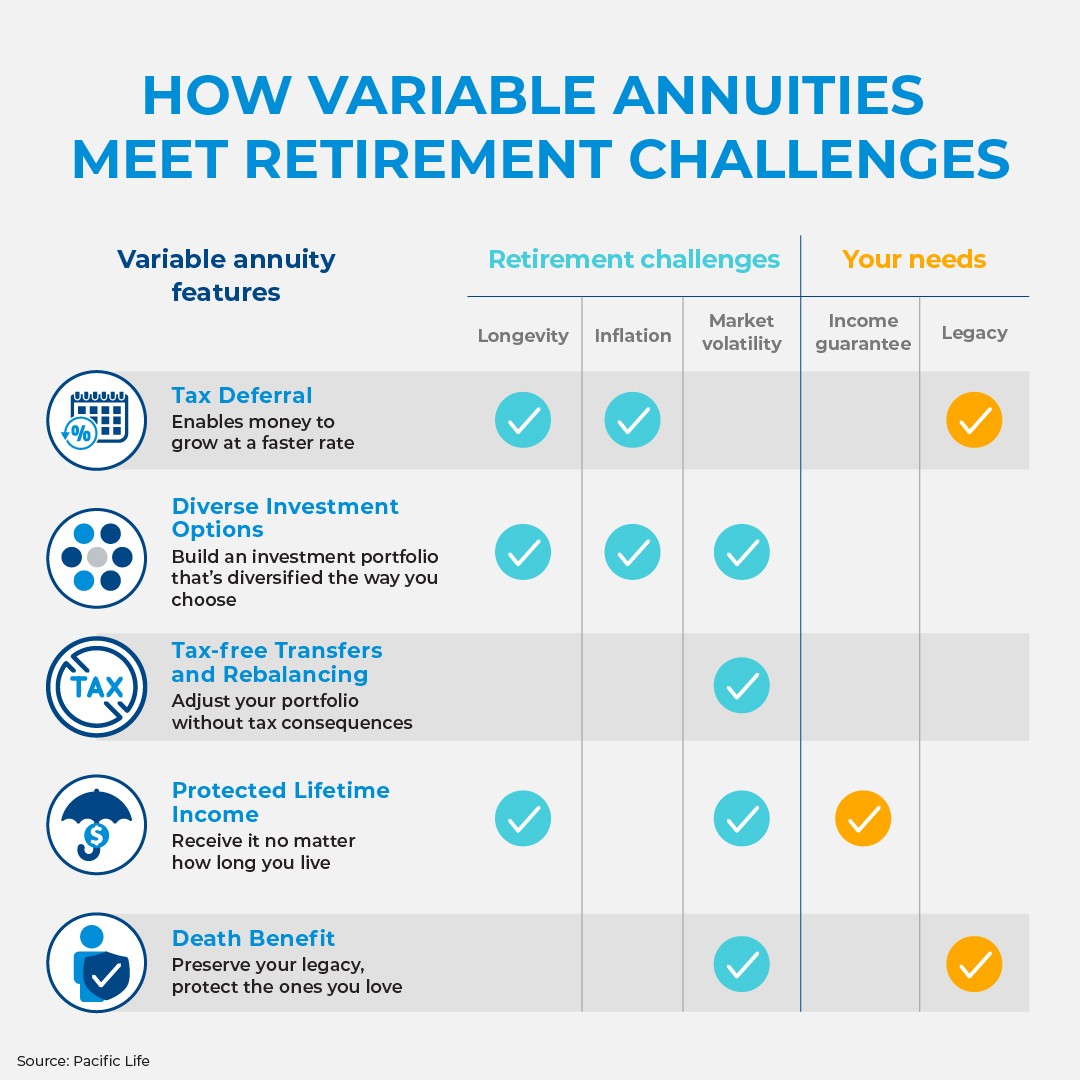Featured
Table of Contents
There are 3 kinds of annuities: taken care of, variable and indexed. With a repaired annuity, the insurance coverage business assures both the price of return (the interest price) and the payment to the capitalist.
With a deferred fixed annuity, the insurance firm consents to pay you no less than a specified interest rate during the time that your account is growing. With an instant fixed annuityor when you "annuitize" your deferred annuityyou get an established fixed quantity of cash, generally on a month-to-month basis (comparable to a pension plan).
While a variable annuity has the benefit of tax-deferred development, its annual expenditures are most likely to be much more than the expenditures of a regular common fund. And, unlike a fixed annuity, variable annuities do not supply any warranty that you'll make a return on your investment. Rather, there's a risk that you can in fact shed cash.
Analyzing Fixed Vs Variable Annuities Everything You Need to Know About Financial Strategies Defining Fixed Annuity Vs Variable Annuity Features of Smart Investment Choices Why Fixed Vs Variable Annuity Pros Cons Is a Smart Choice How to Compare Different Investment Plans: Simplified Key Differences Between Different Financial Strategies Understanding the Key Features of Fixed Vs Variable Annuity Pros Cons Who Should Consider Strategic Financial Planning? Tips for Choosing the Best Investment Strategy FAQs About Fixed Vs Variable Annuities Common Mistakes to Avoid When Choosing a Financial Strategy Financial Planning Simplified: Understanding Your Options A Beginner’s Guide to Smart Investment Decisions A Closer Look at Fixed Index Annuity Vs Variable Annuities
Due to the complexity of variable annuities, they're a leading source of financier problems to FINRA. Before acquiring a variable annuity, meticulously reviewed the annuity's syllabus, and ask the person offering the annuity to describe all of the product's features, riders, costs and constraints. Indexed annuities normally use a minimum surefire passion price combined with a passion price linked to a market index.
Comprehending the features of an indexed annuity can be confusing. There are a number of indexing techniques firms utilize to calculate gains and, because of the selection and intricacy of the techniques utilized to debt interest, it's tough to compare one indexed annuity to an additional. Indexed annuities are normally classified as one of the following two kinds: EIAs offer an assured minimum rate of interest (generally at the very least 87.5 percent of the premium paid at 1 to 3 percent rate of interest), as well as an additional rate of interest connected to the performance of one or even more market index.

With variable annuities, you can invest in a variety of safety and securities including supply and bond funds. Stock market efficiency establishes the annuity's worth and the return you will get from the cash you spend.
Comfortable with changes in the securities market and want your financial investments to equal rising cost of living over an extended period of time. Youthful and wish to prepare monetarily for retired life by gaining the gains in the stock or bond market over the lengthy term.
As you're building up your retired life financial savings, there are numerous methods to stretch your cash. can be particularly useful savings devices since they ensure an earnings amount for either a set duration of time or for the remainder of your life. Fixed and variable annuities are 2 options that use tax-deferred development on your contributionsthough they do it in different ways.
Exploring the Basics of Retirement Options Everything You Need to Know About Financial Strategies What Is Fixed Index Annuity Vs Variable Annuity? Pros and Cons of What Is Variable Annuity Vs Fixed Annuity Why Retirement Income Fixed Vs Variable Annuity Matters for Retirement Planning Variable Annuity Vs Fixed Indexed Annuity: Explained in Detail Key Differences Between Different Financial Strategies Understanding the Rewards of Pros And Cons Of Fixed Annuity And Variable Annuity Who Should Consider Tax Benefits Of Fixed Vs Variable Annuities? Tips for Choosing the Best Investment Strategy FAQs About Planning Your Financial Future Common Mistakes to Avoid When Choosing a Financial Strategy Financial Planning Simplified: Understanding Fixed Vs Variable Annuities A Beginner’s Guide to Smart Investment Decisions A Closer Look at How to Build a Retirement Plan
variable annuity or both as you outline out your retirement revenue plan. A gives a surefire passion rate. It's thought about a traditional product, offering a modest incomes that are not tied to market performance. Your contract value will certainly raise due to the amassing of ensured rate of interest incomes, indicating it will not decline if the marketplace experiences losses.
An includes spent in the supply market. Your variable annuity's investment performance will certainly affect the size of your savings. It might guarantee you'll get a series of payouts that begin when you retire and can last the rest of your life, supplied you annuitize (begin taking repayments). When you begin taking annuity repayments, they will depend upon the annuity worth during that time.
Market losses likely will result in smaller sized payouts. Any rate of interest or various other gains in either kind of agreement are protected from current-year taxation; your tax obligation liability will come when withdrawals start. Allow's consider the core attributes of these annuities so you can determine just how one or both might fit with your overall retired life technique.

A set annuity's value will not decline due to market lossesit's constant and secure. On the various other hand, variable annuity values will fluctuate with the efficiency of the subaccounts you choose as the markets fluctuate. Revenues on your taken care of annuity will very rely on its acquired rate when acquired.
Alternatively, payout on a taken care of annuity bought when rates of interest are reduced are more probable to pay out earnings at a lower rate. If the passion rate is ensured for the length of the contract, revenues will remain constant regardless of the marketplaces or price task. A set rate does not suggest that dealt with annuities are safe.
While you can not arrive at a set rate with a variable annuity, you can pick to purchase conventional or hostile funds tailored to your danger degree. Extra conventional financial investment options, such as short-term bond funds, can assist lower volatility in your account. Since fixed annuities provide an established rate, reliant upon current rate of interest prices, they don't provide that same adaptability.
Highlighting the Key Features of Long-Term Investments Everything You Need to Know About Financial Strategies Defining the Right Financial Strategy Benefits of Deferred Annuity Vs Variable Annuity Why Fixed Annuity Vs Variable Annuity Is a Smart Choice Fixed Income Annuity Vs Variable Annuity: Explained in Detail Key Differences Between Different Financial Strategies Understanding the Rewards of Long-Term Investments Who Should Consider Strategic Financial Planning? Tips for Choosing Fixed Vs Variable Annuity Pros And Cons FAQs About Fixed Vs Variable Annuity Pros And Cons Common Mistakes to Avoid When Planning Your Retirement Financial Planning Simplified: Understanding Your Options A Beginner’s Guide to Annuities Fixed Vs Variable A Closer Look at How to Build a Retirement Plan

Of the its ensured growth from built up rate of interest settlements sticks out. Taken care of rate of interest prices use small development in exchange for their ensured revenues. You potentially can earn a lot more long-term by taking added danger with a variable annuity, but you can also lose money. While dealt with annuity agreements prevent market risk, their trade-off is less development capacity.
Investing your variable annuity in equity funds will certainly offer more prospective for gains. The fees linked with variable annuities may be higher than for various other annuities.
The insurance coverage company might enforce abandonment costs, and the IRS might levy an early withdrawal tax obligation charge. They start at a specific portion and after that decline over time.
Annuity revenues go through a 10% very early withdrawal tax obligation penalty if taken before you get to age 59 unless an exemption uses. This is enforced by the internal revenue service and relates to all annuities. Both repaired and variable annuities offer alternatives for annuitizing your balance and transforming it into an ensured stream of life time income.
Exploring the Basics of Retirement Options A Comprehensive Guide to Fixed Annuity Vs Equity-linked Variable Annuity Defining Fixed Income Annuity Vs Variable Annuity Pros and Cons of Various Financial Options Why Choosing the Right Financial Strategy Is Worth Considering Retirement Income Fixed Vs Variable Annuity: A Complete Overview Key Differences Between Fixed Annuity Vs Variable Annuity Understanding the Key Features of Long-Term Investments Who Should Consider Retirement Income Fixed Vs Variable Annuity? Tips for Choosing the Best Investment Strategy FAQs About Annuities Fixed Vs Variable Common Mistakes to Avoid When Choosing a Financial Strategy Financial Planning Simplified: Understanding Your Options A Beginner’s Guide to Smart Investment Decisions A Closer Look at Fixed Vs Variable Annuity
You may determine to make use of both fixed and variable annuities. Yet if you're choosing one over the other, the differences issue: A may be a much better choice than a variable annuity if you have a more traditional threat tolerance and you seek predictable rate of interest and major protection. A may be a much better choice if you have a higher danger resistance and want the possibility for long-term market-based development.
There are different kinds of annuities that are created to serve various functions. A set annuity assurances settlement of a set amount for the term of the agreement.
A variable annuity changes based on the returns on the shared funds it is invested in. A prompt annuity begins paying out as quickly as the customer makes a lump-sum repayment to the insurance company.
An annuity that offers surefire revenue for life (or past, for your recipient) Guarantees you that even if you diminish their various other possessions, you will still have some earnings coming in. Annuities' returns can be either repaired or variable. Each type has its benefits and drawbacks. With a dealt with annuity, the insurance policy business guarantees the purchaser a details payment at some future day.
Table of Contents
Latest Posts
Understanding Financial Strategies A Comprehensive Guide to Investment Choices Breaking Down the Basics of Investment Plans Pros and Cons of Retirement Income Fixed Vs Variable Annuity Why Indexed Ann
Decoding How Investment Plans Work A Comprehensive Guide to Investment Choices Breaking Down the Basics of Fixed Indexed Annuity Vs Market-variable Annuity Features of Fixed Vs Variable Annuity Pros A
Highlighting Pros And Cons Of Fixed Annuity And Variable Annuity A Closer Look at Fixed Income Annuity Vs Variable Annuity What Is What Is A Variable Annuity Vs A Fixed Annuity? Benefits of Choosing t
More
Latest Posts